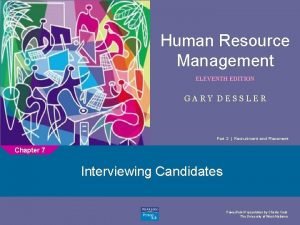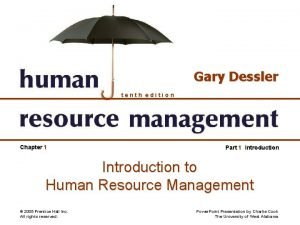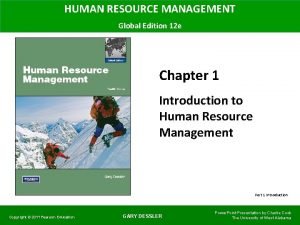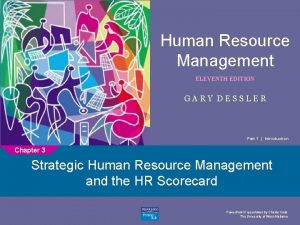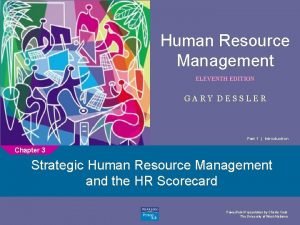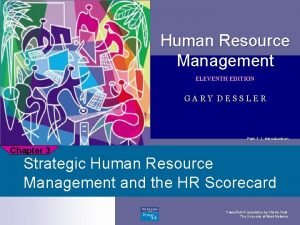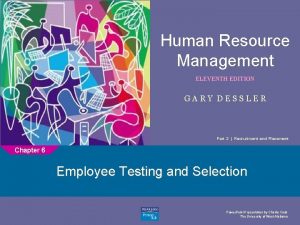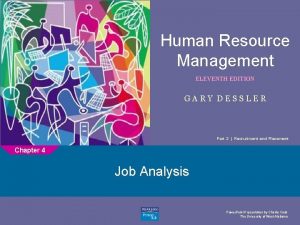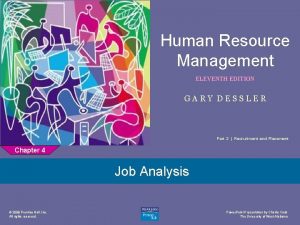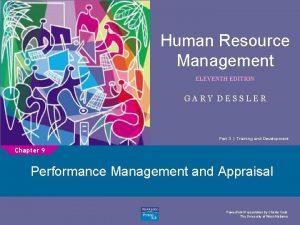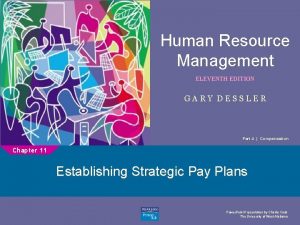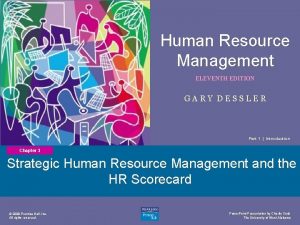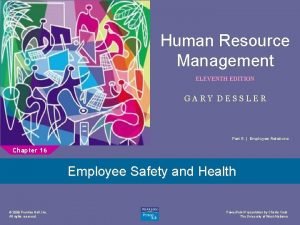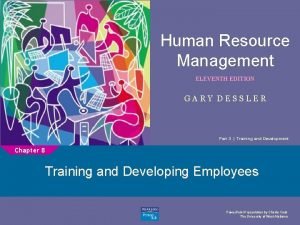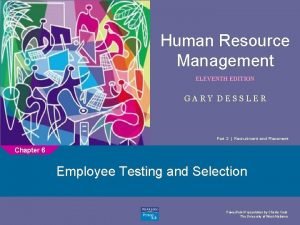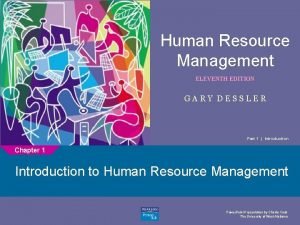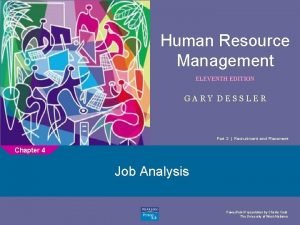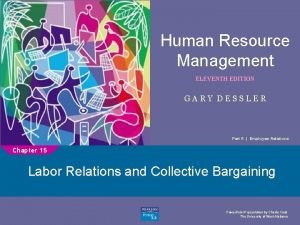Human Resource Management 1 ELEVENTH EDITION GARY DESSLER





















- Slides: 21

Human Resource Management 1 ELEVENTH EDITION GARY DESSLER Part 2 | Recruitment and Placement Chapter 5 Personnel Planning and Recruiting © 2008 Prentice Hall, Inc. All rights reserved. Power. Point Presentation by Charlie Cook The University of West Alabama

After studying this chapter, you should be able to: 1. Explain the main techniques used in employment planning and forecasting. 2. List and discuss the main outside sources of candidates. 3. Effectively recruit job candidates. 4. Name and describe the main internal sources of candidates. 5. Develop a help wanted ad. 6. Explain how to recruit a more diverse workforce. © 2008 Prentice Hall, Inc. All rights reserved. 5– 2

The Recruitment and Selection Process 1. Decide what positions to fill through personnel planning and forecasting. 2. Build a candidate pool by recruiting internal or external candidates. 3. Have candidates complete application forms and undergo initial screening interviews. 4. Use selection tools to identify viable candidates. 5. Decide who to make an offer to, by having the supervisor and others interview the candidates. © 2008 Prentice Hall, Inc. All rights reserved. 5– 3

FIGURE 5– 1 Steps in Recruitment and Selection Process The recruitment and selection process is a series of hurdles aimed at selecting the best candidate for the job. © 2008 Prentice Hall, Inc. All rights reserved. 5– 4

FIGURE 5– 2 Linking Employer’s Strategy to Plans © 2008 Prentice Hall, Inc. All rights reserved. 5– 5

Planning and Forecasting • Employment or Personnel Planning Ø The process of deciding what positions the firm will have to fill, and how to fill them. • Succession Planning Ø The process of deciding how to fill the company’s most important executive jobs. • What to Forecast? Ø Overall personnel needs Ø The supply of inside candidates Ø The supply of outside candidates © 2008 Prentice Hall, Inc. All rights reserved. 5– 6

Forecasting Personnel Needs Forecasting Tools Trend Analysis © 2008 Prentice Hall, Inc. All rights reserved. Ratio Analysis Scatter Plotting 5– 7

FIGURE 5– 3 Determining the Relationship Between Hospital Size and Number of Nurses Note: After fitting the line, you can project how many employees you’ll need, given your projected volume. Size of Hospital (Number of Beds) Number of Registered Nurses 200 240 300 260 400 470 500 600 620 700 660 800 820 900 860 © 2008 Prentice Hall, Inc. All rights reserved. 5– 8

Drawbacks to Traditional Forecasting Techniques • They focus on projections and historical relationships. • They do not consider the impact of strategic initiatives on future staffing levels. • They support compensation plans that reward managers for managing ever-larger staffs. • They give the idea that staff increases are inevitable. • They validate and institutionalize present planning processes and the usual ways of doing things. © 2008 Prentice Hall, Inc. All rights reserved. 5– 9

Using Computers to Forecast Personnel Requirements • Computerized Forecasts Ø Software that estimates future staffing needs by: v Projecting sales, volume of production, and personnel required to maintain different volumes of output. v Forecasting staffing levels for direct labor, indirect staff, and exempt staff(nonexempt are entitled for overtime pay). © 2008 Prentice Hall, Inc. All rights reserved. 5– 10

Forecasting the Supply of Inside Candidates Qualification Inventories Manual Systems and Replacement Charts © 2008 Prentice Hall, Inc. All rights reserved. Computerized Information Systems 5– 11

The Matter of Privacy • Ensuring the Security of HR Information Ø Control of HR information through access matrices Ø Access to records and employee privacy • Legal Considerations Ø The Privacy Act of 1974 Ø Americans with Disabilities Act © 2008 Prentice Hall, Inc. All rights reserved. 5– 12

FIGURE 5– 5 Keeping Data Safe Since intruders can strike from outside an organization or from within, HR departments can help screen out potential identity thieves by following four basic rules: 1. Perform background checks on anyone who is going to have access to personal information. 2. If someone with access to personal information is out sick or on leave, don’t hire a temporary employee to replace him or her. Instead, bring in a trusted worker from another department. 3. Perform random background checks such as random drug tests. Just because someone passed five years ago doesn’t mean their current situation is the same. 4. Limit access to information such as SSNs, health information, and other sensitive data to HR managers who require it to do their jobs. © 2008 Prentice Hall, Inc. All rights reserved. 5– 13

Forecasting Outside Candidate Supply • Factors In Supply of Outside Candidates Ø General economic conditions Ø Expected unemployment rate • Sources of Information Ø Periodic forecasts in business publications Ø Online economic projections v http: //www. pbs. gov. pk/ v http: //data. worldbank. org/country/pakistan © 2008 Prentice Hall, Inc. All rights reserved. 5– 14

Effective Recruiting • External Factors Affecting Recruiting Ø Supply of workers Ø Outsourcing of white-collar jobs Ø Fewer “qualified” candidates • Other Factors Affecting Recruiting Ø Consistency of recruitment with strategic goals Ø Types of jobs recruited and recruiting methods Ø Nonrecruitment HR issues and policies Ø Successful prescreening of applicants Ø Public image of the firm Ø Employment laws © 2008 Prentice Hall, Inc. All rights reserved. 5– 15

Effective Recruiting (cont’d) • Advantages of Centralizing Recruitment Ø Strengthens employment brand Ø Facilitates applying strategic priorities Ø Reduces duplication of HR activities Ø Reduces cost of new HR technologies Ø Builds teams of HR experts Ø Provides better measurement of HR performance Ø Allows for sharing of applicant pools © 2008 Prentice Hall, Inc. All rights reserved. 5– 16

FIGURE 5– 6 Sample Acceptable Questions Once Conditional Offer Is Made 1. Do you have any responsibilities that conflict with the job vacancy? 2. How long have you lived at your present address? 3. Do you have any relatives working for this company? 4. Do you have any physical defects that would prevent you from performing certain jobs where, to your knowledge, vacancies exist? 5. Do you have adequate means of transportation to get to work? 6. Have you had any major illness (treated or untreated) in the past 10 years? 7. Have you ever been convicted of a felony or do you have a history of being a violent person? (This is a very important question to avoid a negligent hiring or retention charge. ) 8. What is your educational background? (The information required here would depend on the job-related requirements of the position. ) © 2008 Prentice Hall, Inc. All rights reserved. 5– 17

Measuring Recruiting Effectiveness Evaluating Recruiting Effectiveness What to Measure © 2008 Prentice Hall, Inc. All rights reserved. How to Measure 5– 18

TABLE 5– 1 Selection Devices that Could be Used to Initially Screen Applicants Selection Device Validity for Predicting Job Performance* Construct General mental ability tests 0. 51 Conscientiousness tests 0. 31 Integrity tests 0. 41 Method Work sample tests 0. 54 Job knowledge tests 0. 48 Structured interviews 0. 51 Biographical data 0. 35 Grade point average 0. 23 Ratings of training and experience 0. 11 Note: *Higher is better. Source: Kevin Carlson et al. , “Recruitment Evaluation: The Case for Assessing the Quality of Applicants Attracted, ” Personnel Psychology 55 (2002), p. 470. © 2008 Prentice Hall, Inc. All rights reserved. 5– 19

FIGURE 5– 7 Recruiting Yield Pyramid © 2008 Prentice Hall, Inc. All rights reserved. 5– 20

Internal Candidates: Hiring from Within Advantages • Foreknowledge of candidates’ strengths and weaknesses • More accurate view of candidate’s skills • Candidates have a stronger commitment to the company • Increases employee morale • Less training and orientation required © 2008 Prentice Hall, Inc. All rights reserved. Disadvantages • Failed applicants become discontented • Time wasted interviewing inside candidates who will not be considered • Inbreeding strengthens tendency to maintain the status quo 5– 21
 Human resource management by gary dessler
Human resource management by gary dessler Management eleventh edition stephen p robbins
Management eleventh edition stephen p robbins Management eleventh edition stephen p robbins
Management eleventh edition stephen p robbins Management eleventh edition
Management eleventh edition Management eleventh edition
Management eleventh edition Hrm by gary dessler
Hrm by gary dessler Gary dessler
Gary dessler Gary dessler
Gary dessler Human resource management 15th edition
Human resource management 15th edition International human resource management dowling 6th edition
International human resource management dowling 6th edition Human resource management fifteenth edition
Human resource management fifteenth edition Demographic trends affecting human resource management
Demographic trends affecting human resource management Time management in human resource management
Time management in human resource management Organized retail
Organized retail Management is universal and everywhere
Management is universal and everywhere Eleventh 5 year plan
Eleventh 5 year plan Eleventh 5 year plan
Eleventh 5 year plan Eleventh plan
Eleventh plan For his eleventh birthday elvis presley
For his eleventh birthday elvis presley White e lippitt propõem três estilos de liderança
White e lippitt propõem três estilos de liderança Alexander fleming
Alexander fleming Hr strategy map
Hr strategy map






